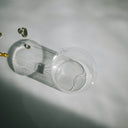Minoxidil has become a popular treatment for hair loss, particularly among men and women experiencing androgenetic alopecia, commonly known as male or female pattern baldness. With its rise in usage, many individuals are curious about its mechanism of action, especially regarding its relationship to dihydrotestosterone (DHT), a hormone linked to hair loss. This article aims to clarify whether minoxidil is a DHT blocker and to provide comprehensive insights into its role in hair regrowth.
Table of content
Is minoxidil a DHT blocker?
No, minoxidil is not a DHT blocker. Instead, minoxidil is a vasodilator that works by increasing blood flow to hair follicles, which can stimulate hair growth. While it does not directly inhibit DHT, it may help counteract the effects of DHT-induced hair follicle shrinkage by promoting a healthier environment for hair growth. DHT is a byproduct of testosterone and is known to contribute to hair loss in genetically predisposed individuals. To effectively combat hair loss related to DHT, treatments such as finasteride, which specifically inhibits the enzyme responsible for converting testosterone to DHT, are often recommended alongside minoxidil.
To understand the role of minoxidil in hair loss treatment, it’s essential to explore its mechanism, the nature of DHT, and the potential combined use of different hair loss treatments.
As your leading source for hair health information over the past 4 years, we never compromise on accuracy. When it comes to your health, you deserve information you can truly rely on - and earning your trust is our top priority.
Here's how Scandinavian Biolabs ensures every piece of content meets the highest standards of accuracy and integrity:
- Credentialed Experts: Our reviewers are actively practicing doctors and medical researchers
- Stringent Reviews: Content undergoes rigorous editing by subject specialists and review by a practicing doctor.
- Evidence-Based: We rely on well-established research from trusted scientific sources like peer-reviewed journals and health authorities.
- Full Transparency: Our editorial standards, writer credentials, reviewer credentials, correction process, and funding are all publicly documented.
- Independent Voice: While we do promote products, we operate in a vacuum to business operations. Our main goal is just an unwavering commitment to providing medically-sound guidance.
You can count on Scandinavian Biolabs to consistently deliver the trustworthy health information you deserve. Read our Editorial Standards.
Understanding Minoxidil
Minoxidil was initially developed as a treatment for high blood pressure. However, during clinical trials, researchers found that it not only lowered blood pressure but also stimulated hair growth in individuals with certain types of hair loss. This led to its approval as a topical solution for treating hair loss. Available in both liquid and foam formulations, minoxidil is applied directly to the scalp where hair thinning occurs.
How Does Minoxidil Work?
Minoxidil works primarily as a vasodilator. When applied to the scalp, it widens the blood vessels, which increases blood flow and oxygen delivery to the hair follicles. This enhanced circulation nourishes the hair follicles, potentially revitalizing dormant follicles and encouraging hair regrowth. The exact mechanism by which minoxidil promotes hair growth is not completely understood, but it is believed to extend the anagen (growth) phase of the hair cycle and increase the size of hair follicles.
The Role of DHT in Hair Loss
Dihydrotestosterone (DHT) is a derivative of testosterone, formed by the action of the enzyme 5-alpha reductase. DHT is known to bind to androgen receptors in hair follicles, leading to a process called miniaturization. This process shrinks hair follicles, resulting in thinner, shorter hair strands and eventually leading to hair loss. Individuals with a genetic predisposition to androgenetic alopecia may experience significant hair loss due to the effects of DHT.
Minoxidil vs. DHT Blockers
While minoxidil helps to promote hair growth through increased blood flow, it does not interfere with DHT levels or inhibit its effects. DHT blockers, such as finasteride and dutasteride, work by preventing the conversion of testosterone to DHT, thus reducing the overall levels of DHT in the body. These treatments can be effective in slowing or stopping hair loss related to DHT, making them a complementary option to minoxidil for those seeking to combat hair loss.
Combining Minoxidil with DHT Blockers
Many individuals find success in treating hair loss by combining minoxidil with DHT blockers. This dual approach addresses both the hormonal aspect of hair loss (via DHT blockers) and the stimulation of hair growth (via minoxidil). Studies have shown that using both treatments together can lead to improved hair regrowth outcomes compared to using either treatment alone.
Side Effects of Minoxidil
While minoxidil is generally well-tolerated, some users may experience side effects. Common side effects include itching, dryness, and flaking of the scalp. In rare cases, users may experience more severe reactions, such as rapid heart rate, dizziness, or swelling. It is essential for individuals to follow the usage instructions and consult with a healthcare professional if they experience any adverse effects.
Conclusion
In summary, minoxidil is not a DHT blocker; rather, it functions as a vasodilator to promote hair regrowth by increasing blood flow to hair follicles. For individuals struggling with hair loss attributable to DHT, it may be beneficial to consider DHT blockers in conjunction with minoxidil for a comprehensive treatment approach. As with any health-related treatment, consulting a healthcare provider is advisable to determine the best course of action tailored to individual needs.
```Minoxidil Side Effects Got You Down? There's A Plant-Based, Drug-Free Option.
Minoxidil can be a double-edged sword for hair regrowth. It works, but often comes with scalp irritation and unwanted hair growth. Maybe you'd prefer a gentler approach altogether?
The good news is, effective alternatives exist. Many simply aren't aware of them.
Here's what you likely crave:
- Soothe the Scalp: Ditch the itch and irritation.
- See Real Results: Noticeable hair regrowth, not just less shedding.
- Safe for Everyday Use: A trusted product you can rely on.
Bio-Pilixin® to the Rescue
Bio-Pilixin® is a clinically tested, drug-free answer to your hair loss woes.
- Gentle Yet Effective: Powerful results without harsh chemicals.
- Help Reduce Shedding, Increase Growth: Studies show significant hair regrowth for users.
- Safe & Plant-powered Formula: Confidence you can use Bio-Pilixin® daily.
Bio-Pilixin® offers the powerful, yet gentle approach you've been searching for.
Read more:






